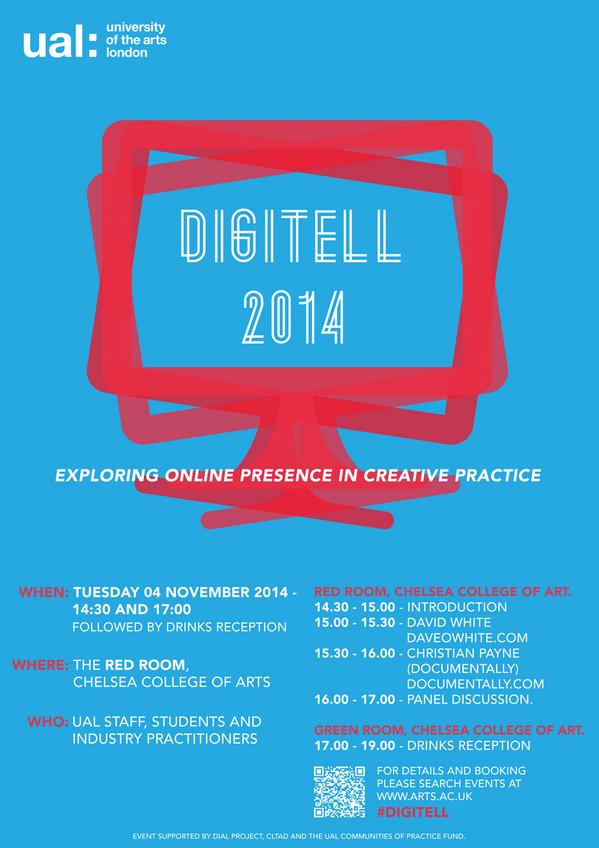It was lovely to be invited to speak alongside Christian Payne (@Documentally) at the Digitell symposium held at The University of the Arts London. The focus of the student run event was digital identity, one of the themes students had highlighted out of a community of practice supported by the Jisc funded ‘DIAL’ project and CLTAD.
So I rolled up my thinking-sleeves and considered the way identity functions in the creative arts… The result was a talk which included Duchamp, Abramović and Banksy. Obviously it’s a complex subject and many have been lost down the rabbit-hole of identity but I gave it my best shot.

With Fountain Duchamp shifted the emphasis away from the artist as sole generator of meaning but the effect of this move to the conceptual appears to have put more rather than less focus on the identity of the artist. If the art is a found object we want to know even more about what the artist was thinking and ‘who they are’. The work/piece and the identity of the artist are inextricably linked. Abramović’s The Artist is Present is the absolute extreme of this, she is both her ‘self’ and a found object. I finished this section of the talk by pointing out that a Banksy piece is valuable because of its attachment to ‘Bansky’ as an identity even though he/she is anonymous. Even when the identity of the creator is not known it is still a powerful influence on the way we interpret and receive the work.
My overall point here is that people are fascinated by people and most work, artistic or otherwise, is an expression of identity in some form. To my mind ‘identity’ is a proxy for ‘humanness’.
In digital contexts I suggested that there are two major ways of realising an identity online:
- Identity embodied through works (Abramović being the most pointed example).
Rather than being present directly online in social media or similar spaces individuals can express themselves through objects/work they have created. This is where the notion of the Web as a ‘Shop Window’ works well (see my Breaking Down Digital post). This form of online identity only functions when the work is created in an ‘I made this’ mode. Obviously this is closely aligned with the creative arts but I’d argue that anyone who has written an academic paper for example is doing the same thing. Our online identity is the sum of what we post and what is posted about us. This includes anything that has our name/pseudonym linked to it. The significant point here is that there is little desire for visible discourse online around the work by those posting it. The way to connect is likely to be ‘email me if you are interested’ or similar.
- Identity expressed through discourse
This is where the Web is a series of spaces where we can be co-present with others, where thoughts are expressed with the expectation of response. Identity in this mode is more directly linked to a notion of the individual’s persona and presence rather than mediated or expressed through ‘finished’ work. This is likely to involve real-time or nearly-real-time discourse and connection with those around them. This is the highly Resident form of online identity of which Christian Payne was a great example. While identity embodied via work is likely to be focused on finding an audience identity expressed through discourse it likely to be about building networks and communities.
An interesting overlap between these forms of identity is the opportunity to reveal aspects of the process involved in heading towards a finished piece of work and seek comment/input. This is one of the most powerful and potentially rewarding ways of operating and being present online and acts as a good transition between ‘Shop Window’ and more Resident forms of engagement.
I finished by suggesting that one of the advantages of a digital identity is that we can shape, nurture and control it to a certain extent. We can decide who-we-are online but only if we have a clear idea of what we are trying to achieve. Christian then went on to challenge this perspective by describing how his online identity was owned/mediated by the people who engage with him – he didn’t control the interpretation of his identity. (a statement which @otheragent pointed out echoes the notion of the art coefficient — the difference between what the artist intended and how the world interprets it)
In the panel session we went on to discuss a broad range of topics including authenticity and value. What interested me most in the discussion was that while Christian felt authenticity was important in online identity he does chose what to post and what not to post, thereby controlling his identity with great nuance without necessarily being inauthentic. Personally I’m not sure what authenticity is but that’s a different rabbit hole…
Thanks to Kimberly Cunningham, Joe Easeman and Chris Follows for running such great event.
